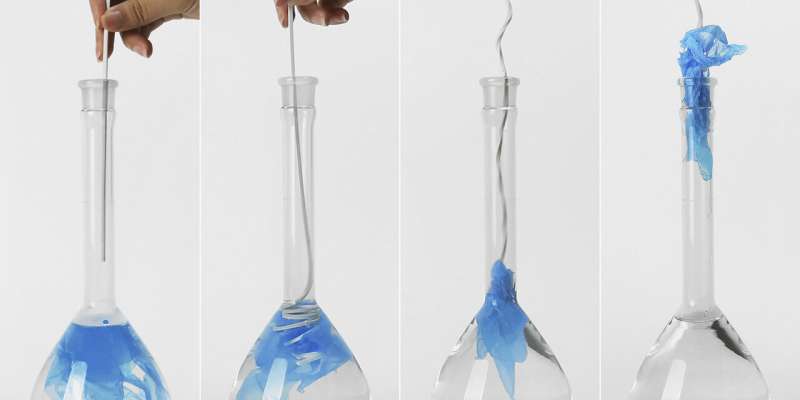One-dimensional objects morph into new dimensions

A line is the shortest distance between two points, but "A-line," a 4-D printing system developed at Carnegie Mellon University, takes a more circuitous route. One-dimensional, "line"-shaped plastic structures produced with the A-line system can bend, fold and twist themselves into predetermined shapes when triggered by heat.
3-D-printed objects that later change shape are the very definition of 4-D printing. But the process takes on special qualities when the objects can fit through narrow openings. A rod inserted through a narrow bottleneck, for instance, might transform into a hook to fish an object out of the bottle. Or a long, thin fastener inserted through holes in the seat of a chair might lock a chair leg into place.
The A-line method also can be useful in making compliant devices, such as coil springs and tweezers. These are difficult to produce in final form using a 3-D printer, but can be printed readily as rods that assume final form when dipped in hot water.
Making sticks that morph into new objects is a feat that Lining Yao, assistant professor in CMU's Human-Computer Interaction Institute, and her colleagues in the Morphing Matter Lab have accomplished using an ordinary, hobbyist-grade 3-D printer and a single type of thermoplastic material.
"It's not printing the line that's difficult, but it's developing the software tool that enables you to design, simulate and fabricate the line," Yao explained.
The group used polylactic acid, or PLA—the most common material used in 3-D printing—to produce their objects. PLA shrinks in reaction to heat along the direction in which it was printed, said Guanyun Wang, a post-doctoral fellow in the Morphing Matter lab. That makes it possible to control how an object's shape will morph based on the spacing of active and passive segments, the thickness of segments and on the printing direction of each segment, he explained.
The A-line platform developed by Yao's team includes a library of eight bending directions that can be combined to produce simple or complex geometries. It also includes a customized design tool to help users combine these different types of bends to achieve desired shapes.

Ye Tao, a visiting scholar at the HCII from Zhejiang University, said the team triggered the bending by immersing the engineered sticks into water heated to about 170 degrees Fahrenheit. Morphing also can be triggered by a heat gun, with embedded carbon fiber for resistive heating or with steam via hollow channels in the sticks.
As with other 4-D-printed objects, one advantage of the A-line rods is that they can be shipped as a flat pack and triggered on site to become tent supports, chair frames or sculptures. But Yao envisions some applications that are peculiar to line-shaped objects. By using electrical field responsive hydrogels instead of PLA, for instance, it might be possible to develop a biocompatible line that a surgeon could snake through narrow body spaces and remotely transform into surgical tweezers. By controlling electrical fields, it might also be possible to control the tweezer movement.
"Through this work, we hope to enlarge the design space of 4-D printing technology," Yao said. "We encourage designers to think about additional novel uses of A-line."
A research paper describing A-Line was presented earlier this year at CHI 2019, the Association for Computing Machinery's Conference on Human Factors in Computing Systems.
More information: For more information, see morphingmatter.cs.cmu.edu/a-line/




















